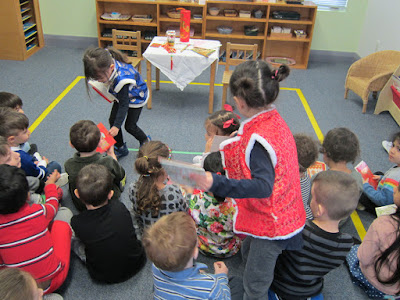~ This post is the second in a series about the Golden Bead Material. ~
Once a child has been introduced to the Decimal System material, they will begin
to use it to form complex numbers.
The purpose of this exercise is to make the child aware of the hierarchy of the
decimal system. The digits 1 to 9 remain the same. It is the place the digit occupies in the complex number - units, tens, hundreds, thousands - which gives it its meaning. It is also to show that zero is a place holder for an empty category. (In the number 2, 307, zero shows us that one of the categories, the tens, are missing.) Through this material, the child is given practice in the interpretation
of complex numbers and is introduced to the proper wording.
The
child is asked to set out the Golden Bead Material on one mat and the Large
Number Cards on another mat.
 |
| Setting Out the Large Number Cards |
 |
| Setting Out The Limited Bead Material |
 |
| (r to l) Units, Tens, Hundreds, Thousand |
For the
first exercise, the teacher sits at the mat with the number cards and places
one card from the units category on a child's tray. The child is asked to go
to the mat with the Golden Bead Material and get this amount. When the child returns, the child is asked to
count the beads to confirm the amount.
When the child is familiar with the units, a card from the next category is added. Now the child has a card from the units category and another card from the tens category. Again, the child is asked to
go to the mat with the Golden Bead Material and get this amount. When the child returns, the child is asked to
count both sets of beads aloud, first the units and next the tens.
 |
| 2 Units, 6 Tens |
The
teacher will then “do something special with the cards” and place the units
card face up on top of the tens card (the units card is not placed on the zero
of the tens card at this point).
 |
| The units card is placed on top of the tens card. |
While
the child is watching, the teacher gently pushes the edge of the bottom card
against the palm of the hand so that the units card slides down over the zero
on the tens card.
 |
| The teacher slides the unit card down over the zero on the tens card. |
The
teacher will ask ‘What did you bring?’
The child will say ‘two units’ and ‘six tens’. The teacher says “We call six tens and two units, ‘sixty-two’”. This work
continues with new numbers. Once the
child has mastered two categories (units and tens) another category is
added. After the first presentation, the
child may slide the cards.
 |
| Sixty-two |
The formation and reading of complex numbers (example - 4,239) leads to work with the operations (addition, subtraction, multiplication and division). A future blog post will discuss operations with the Golden Bead Material.
This material is used extensively in the Montessori preschool (casa) and early elementary. It is introduced to children at 4 - 4 1/2 years of age.

























